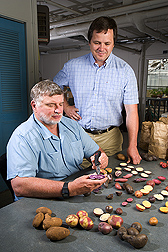This page has been archived and is being provided for reference purposes only. The page is no longer being updated, and therefore, links on the page may be invalid.
Read the magazine story to find out more. |
|
|
Potatoes Chock Full of Phytochemicals
By Jan SuszkiwSeptember 7, 2007
Americans love their spuds, consuming 130 pounds per person annually. Now that culinary love affair could grow even more passionate with Agricultural Research Service (ARS) findings that some potato varieties are packed with health-promoting compounds called phytochemicals.
Using a new analytical method, ARS plant geneticist Roy Navarre and colleagues in Washington State and Oregon have identified 60 different kinds of phytochemicals and vitamins in the skins and flesh of 100 wild and commercially grown potatoes.
The team's analysis of Red and Norkotah potatoes, for example, revealed that the spuds' total dietary-phenolics content rivaled that of broccoli, spinach and brussel sprouts. These phenols included the flavonoids subgroup, which may play a role in helping diminish cardiovascular disease, respiratory problems and certain cancers, notes Navarre, at the ARS Vegetable and Forage Crops Research Unit in Prosser, Wash.
His team also identified potatoes with high levels of vitamin C, folic acid, quercetin and kukoamines. These last compounds are of interest for their potential to lower blood pressure, and have only been found in one other plant, Lycium chinense.
Navarre began his "phytochemical profiling" of potatoes in 2006, working with ARS geneticist Chuck Brown at Prosser, research associate Roshani Shakya at Washington State University, and research associate Aymeric Goyer at Oregon State University.
Earlier investigations of phytochemicals in potatoes and other crops have been limited to one or two varieties. But Navarre's team significantly expanded the search by using a method that draws on high-throughput liquid chromatography and mass spectrometry. Their analysis of wild and cultivated potatoes, for example, revealed phenolic concentrations of 100 to 675 milligrams per 100 grams dry weight.
Eventually, potato breeders, distributors and farmers will be able to use the team's phytochemical profiles to explore new consumer markets, or even develop entirely new varieties based on the dietary findings of nutritional science.
Read more about their work in the September 2007 issue of Agricultural Research magazine.
ARS is the U.S. Department of Agriculture's chief scientific research agency.

